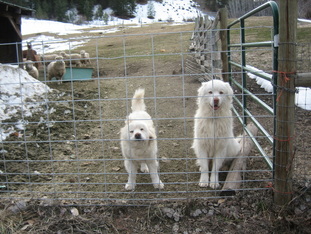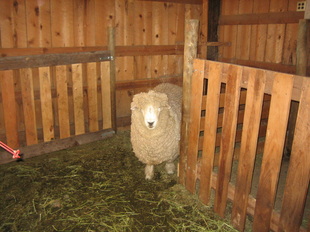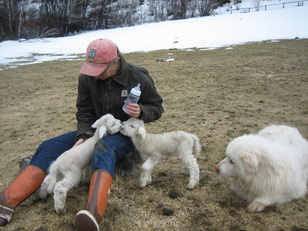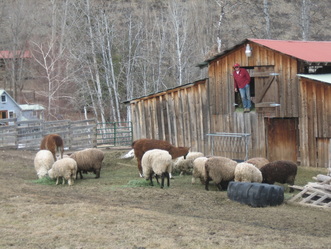
The Farm
McFarland Creek Lamb Ranch is a small farm located in the Methow Valley in North Central Washington State on the site of an old hydro power plant that supplied electricity to the local schoolhouse in the early 20th century. Although only remnants of the original power plant equipment remain, the year round creek is still used to provide abundant water for pasture, fruit trees and a small garden. We maintain a small flock of sheep that feed on lush pasture in the summer months, and local hay in the winter. Our philosophy is to practice sustainability and use our resources in the most efficient and responsible way possible.
McFarland Creek Lamb Ranch is a small farm located in the Methow Valley in North Central Washington State on the site of an old hydro power plant that supplied electricity to the local schoolhouse in the early 20th century. Although only remnants of the original power plant equipment remain, the year round creek is still used to provide abundant water for pasture, fruit trees and a small garden. We maintain a small flock of sheep that feed on lush pasture in the summer months, and local hay in the winter. Our philosophy is to practice sustainability and use our resources in the most efficient and responsible way possible.
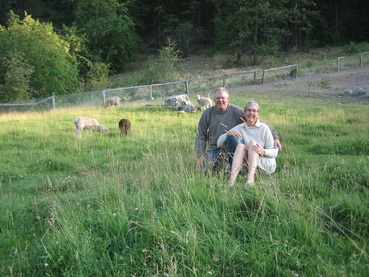
The Owners
Bill Tackman is a third generation rancher who grew up on a sheep and cattle ranch in SE Oregon. He worked and traveled for many years before settling in the Methow Valley where he had been visiting his brother since the mid-1970’s. He became a licensed land surveyor in 2001 and opened his own surveying business in Winthrop, WA in 2005. His love of the land and the rural life led him to return to his ranching roots and he couldn’t resist starting his own flock of sheep when he purchased the farm in 1996.
Katie Haven recently retired after a 26 year career as a Merchant Mariner, the last 13 years as a Chief Engineer for the Alaska Ferries. She is an avid knitter and is enjoying being on land full time. She handles many of the daily chores on the ranch, washes and dyes the wool, and tends the garden.
Bill Tackman is a third generation rancher who grew up on a sheep and cattle ranch in SE Oregon. He worked and traveled for many years before settling in the Methow Valley where he had been visiting his brother since the mid-1970’s. He became a licensed land surveyor in 2001 and opened his own surveying business in Winthrop, WA in 2005. His love of the land and the rural life led him to return to his ranching roots and he couldn’t resist starting his own flock of sheep when he purchased the farm in 1996.
Katie Haven recently retired after a 26 year career as a Merchant Mariner, the last 13 years as a Chief Engineer for the Alaska Ferries. She is an avid knitter and is enjoying being on land full time. She handles many of the daily chores on the ranch, washes and dyes the wool, and tends the garden.
|
The Animals
Bill chose Romney sheep because they are a proven dual-purpose animal that provides much sought after meat and wool. The sheep have a calm disposition and have adapted well to the harsh climate in this area. We acquired a Cormo ram in 2014 and have been cross breeding him with our Romney ewes to improve our fiber quality. By keeping the flock small, we can rotate them between 6 pastures which gives ample time for each pasture to recover between grazing periods. We breed our ewes once a year in the fall, so that they will give birth to their lambs in early April. Shearing takes place in late March before lambing. We do not use any antibiotics or other drugs with our animals unless it's necessary to save their life, which happens rarely. The lambs stay with their mothers until they are naturally weaned, and then feed on pasture and water that is piped from the fresh mountain creek via a gravity system. Predators are always an issue- in our area we have mostly cougar, coyotes, and as of 2008, wolves. Our philosophy is to co-exist with these animals and we feel it is our responsibility to use preventive measures such as good fencing and guard animals rather than trapping and eradication. Our first attempt to protect the flock was to acquire two llamas, which helped to keep the coyotes at bay, but we still lost several sheep to cougar. We got our first purebred Maremma guard dogs, Cas & Nellie in 2006, and have since acquired two more to take over the guarding duties. Their mission in life is to protect the sheep, and they take it very seriously. Since we have had them, predators have been rare visitors. |

